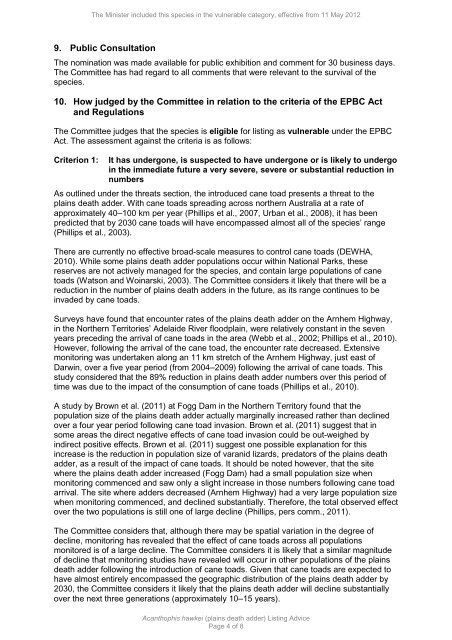Plains Death Adder - Department of the Environment, Water ...
Plains Death Adder - Department of the Environment, Water ...
Plains Death Adder - Department of the Environment, Water ...
You also want an ePaper? Increase the reach of your titles
YUMPU automatically turns print PDFs into web optimized ePapers that Google loves.
The Minister included this species in <strong>the</strong> vulnerable category, effective from 11 May 2012<br />
9. Public Consultation<br />
The nomination was made available for public exhibition and comment for 30 business days.<br />
The Committee has had regard to all comments that were relevant to <strong>the</strong> survival <strong>of</strong> <strong>the</strong><br />
species.<br />
10. How judged by <strong>the</strong> Committee in relation to <strong>the</strong> criteria <strong>of</strong> <strong>the</strong> EPBC Act<br />
and Regulations<br />
The Committee judges that <strong>the</strong> species is eligible for listing as vulnerable under <strong>the</strong> EPBC<br />
Act. The assessment against <strong>the</strong> criteria is as follows:<br />
Criterion 1:<br />
It has undergone, is suspected to have undergone or is likely to undergo<br />
in <strong>the</strong> immediate future a very severe, severe or substantial reduction in<br />
numbers<br />
As outlined under <strong>the</strong> threats section, <strong>the</strong> introduced cane toad presents a threat to <strong>the</strong><br />
plains death adder. With cane toads spreading across nor<strong>the</strong>rn Australia at a rate <strong>of</strong><br />
approximately 40–100 km per year (Phillips et al., 2007, Urban et al., 2008), it has been<br />
predicted that by 2030 cane toads will have encompassed almost all <strong>of</strong> <strong>the</strong> species’ range<br />
(Phillips et al., 2003).<br />
There are currently no effective broad-scale measures to control cane toads (DEWHA,<br />
2010). While some plains death adder populations occur within National Parks, <strong>the</strong>se<br />
reserves are not actively managed for <strong>the</strong> species, and contain large populations <strong>of</strong> cane<br />
toads (Watson and Woinarski, 2003). The Committee considers it likely that <strong>the</strong>re will be a<br />
reduction in <strong>the</strong> number <strong>of</strong> plains death adders in <strong>the</strong> future, as its range continues to be<br />
invaded by cane toads.<br />
Surveys have found that encounter rates <strong>of</strong> <strong>the</strong> plains death adder on <strong>the</strong> Arnhem Highway,<br />
in <strong>the</strong> Nor<strong>the</strong>rn Territories’ Adelaide River floodplain, were relatively constant in <strong>the</strong> seven<br />
years preceding <strong>the</strong> arrival <strong>of</strong> cane toads in <strong>the</strong> area (Webb et al., 2002; Phillips et al., 2010).<br />
However, following <strong>the</strong> arrival <strong>of</strong> <strong>the</strong> cane toad, <strong>the</strong> encounter rate decreased. Extensive<br />
monitoring was undertaken along an 11 km stretch <strong>of</strong> <strong>the</strong> Arnhem Highway, just east <strong>of</strong><br />
Darwin, over a five year period (from 2004–2009) following <strong>the</strong> arrival <strong>of</strong> cane toads. This<br />
study considered that <strong>the</strong> 89% reduction in plains death adder numbers over this period <strong>of</strong><br />
time was due to <strong>the</strong> impact <strong>of</strong> <strong>the</strong> consumption <strong>of</strong> cane toads (Phillips et al., 2010).<br />
A study by Brown et al. (2011) at Fogg Dam in <strong>the</strong> Nor<strong>the</strong>rn Territory found that <strong>the</strong><br />
population size <strong>of</strong> <strong>the</strong> plains death adder actually marginally increased ra<strong>the</strong>r than declined<br />
over a four year period following cane toad invasion. Brown et al. (2011) suggest that in<br />
some areas <strong>the</strong> direct negative effects <strong>of</strong> cane toad invasion could be out-weighed by<br />
indirect positive effects. Brown et al. (2011) suggest one possible explanation for this<br />
increase is <strong>the</strong> reduction in population size <strong>of</strong> varanid lizards, predators <strong>of</strong> <strong>the</strong> plains death<br />
adder, as a result <strong>of</strong> <strong>the</strong> impact <strong>of</strong> cane toads. It should be noted however, that <strong>the</strong> site<br />
where <strong>the</strong> plains death adder increased (Fogg Dam) had a small population size when<br />
monitoring commenced and saw only a slight increase in those numbers following cane toad<br />
arrival. The site where adders decreased (Arnhem Highway) had a very large population size<br />
when monitoring commenced, and declined substantially. Therefore, <strong>the</strong> total observed effect<br />
over <strong>the</strong> two populations is still one <strong>of</strong> large decline (Phillips, pers comm., 2011).<br />
The Committee considers that, although <strong>the</strong>re may be spatial variation in <strong>the</strong> degree <strong>of</strong><br />
decline, monitoring has revealed that <strong>the</strong> effect <strong>of</strong> cane toads across all populations<br />
monitored is <strong>of</strong> a large decline. The Committee considers it is likely that a similar magnitude<br />
<strong>of</strong> decline that monitoring studies have revealed will occur in o<strong>the</strong>r populations <strong>of</strong> <strong>the</strong> plains<br />
death adder following <strong>the</strong> introduction <strong>of</strong> cane toads. Given that cane toads are expected to<br />
have almost entirely encompassed <strong>the</strong> geographic distribution <strong>of</strong> <strong>the</strong> plains death adder by<br />
2030, <strong>the</strong> Committee considers it likely that <strong>the</strong> plains death adder will decline substantially<br />
over <strong>the</strong> next three generations (approximately 10–15 years).<br />
Acanthophis hawkei (plains death adder) Listing Advice<br />
Page 4 <strong>of</strong> 8















